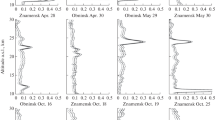Abstract
The results of two-frequency lidar sounding of the atmosphere at the Kamchatka lidar station (52°58′17″ N, 158°15′07″ E) are presented. The scattering signals were recorded in the altitude range 25–600 km. Lasers with radiation at wavelengths of 532.08 and 561.106 nm were used. The aerosol formation in the middle atmosphere and resonance scattering by excited atomic nitrogen and oxygen ions in the upper atmosphere are studied. Pronounced light-scattering layers have been revealed at altitudes of 200–400 km. Their appearance is due to the presence of excited atomic oxygen and nitrogen ions. The difference in signal values at two wavelengths is discussed. A way of signal generation is suggested; signal values at different wavelengths are estimated.




Similar content being viewed by others
REFERENCES
V. V. Bychkov, Y. A. Nepomnyashchiy, A. S. Perezhogin, and B. M. Shevtsov, “Lidar returns from the upper atmosphere and possible causes of their generation,” Atmos. Ocean. Opt. 28 (4), 303–307 (2015).
V. V. Bychkov, I. N. Seredkin, A. S. Perezhogin, B. M. Shevtsov, and V. N. Marichev, “Lidar investigations of the resonance scattering of the atmosphere on exited ions of atomic nitrogen and oxygen,” Optika Atmo-s. Okeana 30 (3), 209–213 (2017).
V. V. Bychkov, A. S. Perezhogin, I. N. Seredkin, and B. M. Shevtsov, “On the role of the method of measuring the background signal in the lidar measurements of the upper atmosphere,” Proc. SPIE—Int. Soc. Opt. Eng. 10466, 1046677 (2017).
V. V. Bychkov, A. S. Perezhogin, I. N. Seredkin, and B. M. Shevtsov, “Appearance of light-scattering layers in the thermosphere of Kamchatka during the autumn of 2017,” Proc. SPIE—Int. Soc. Opt. Eng. 10833, 10833 (2018).
A. Kramida, Yu. Ralchenko, and J. Reader, NIST ASD TEAM. NIST Atomic Spectra Database (Ver. 5.5.2), https://physics.nist.gov/asd. Cited May 19, 2020.
A. F. Yakovets, V. V. Vodyannikova, K. Zh. Nurmukhmbetova, Sh. I. Gordienko, and Yu. G. Litvinov, “F region of the ionosfere during the sunrise,” Izv. Natsional’noi Akad. Nauk Respubliki Kazakhstan. Ser. Fiz.-Mat. No. 4, 3–9135 (2012).
P. J. Richards, “Reexamination of ionospheric photochemistry,” J. Geophys. Res. 116 (A08307), 1–14 (2011).
M. G. Deminov, “Earth’s ionosphere,” in Plasma Heliogeophysics (Fizmatlit, Moscow, 2008), vol. 2, p. 92.
M. G. Deminov and V. V. Khegai, “Analytical approximation of the ionization rate by auroral electrons,” Geomag. Aeron. 20 (1), 145–147 (1980).
M. N. Rees and P. C. Benedict, “Auroral proton oval,” J. Geophys. Res. 75, 1763 (1970).
A. Omkhol’t, Polar Auroras, Ed. by Ya.I. Fel’dshtein and N.N. Shefov (Mir, Moscow, 1974) [in Russian].
M. Picone, A. E. Hedin, and D. Drob, NRLMSISE-00 Model 2001. https://ccmc.gsfc.nasa.gov/modelweb/ atmos/nrlmsise00.html. Cited May 19, 2020.
S. V. Avakyan, A. E. Serova, and N. A. Voronin, “The role of Rydberg atoms and, olecules in the upper atmosphere,” Geomag. Aeron. 37 (3), 99–103 (1997).
G. V. Andreev, “Calculation of the electron impact ionization cross section for hydrogen and nitrogen atoms,” Fiz.-Khimich. Kinetika Gazovoi Dinamike 1 (1), 263–264 (2010).
N. N. Shchefov, A. I. Semenov, and V. Yu. Khomich, Emission of the Upper Atmosphere as an Indicator of Its Structure and Dynamics (GEOS, Moscow, 2006) [in Russian].
O. V. Konstantinov and A. V. Matveentsev, “GIANT cross section of resonant electromagnetic wave scattering by electron in metal and semiconductor clusters,” Tech. Phys. Lett. 36 (11), 1032–1033 (2010).
ACKNOWLEDGMENTS
The work was performed with the use of the equipment of the Common Use Center of IKIR FEB RAS North-Eastern Heliogeophysical Center CKR_558279, UNU 351757.
Funding
The work was performed within the State Assignment on the theme “Dynamics of Physical Processes in Active Zones of Near Space and Geospheres” (2018–2020) (no. AAAA-А21-121011290003-0).
Author information
Authors and Affiliations
Corresponding authors
Ethics declarations
The authors declare that they have no conflicts of interest.
Additional information
Translated by O. Ponomareva
Rights and permissions
About this article
Cite this article
Bychkov, V.V., Seredkin, I.N. Resonance Scattering in the Thermosphere as an Indicator of Superthermal Electron Precipitation. Atmos Ocean Opt 34, 26–33 (2021). https://doi.org/10.1134/S1024856021010048
Received:
Revised:
Accepted:
Published:
Issue Date:
DOI: https://doi.org/10.1134/S1024856021010048




